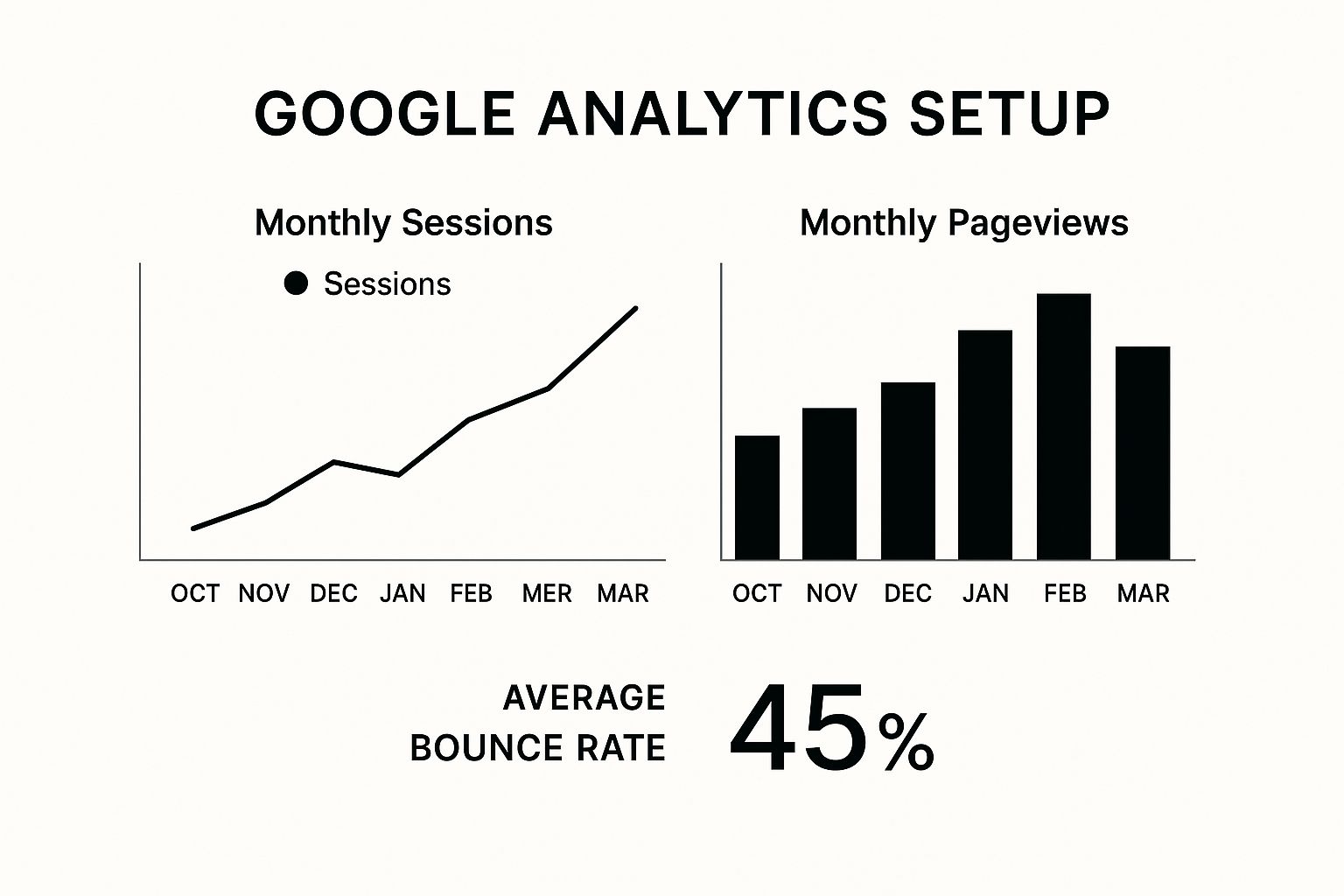How to Track SEO Performance: Essential Tips & Tools
How to Track SEO Performance: Essential Tips & Tools
Why SEO Tracking Is No Longer Optional

In today's competitive online marketplace, knowing how to track SEO performance is essential. Think of a ship navigating without a compass or map. Running an SEO campaign without tracking is similar. You’re putting in the work, but you don't know where you’re going or how you're progressing. This can lead to wasted resources and lost opportunities. Tracking your performance gives you the insights to steer your SEO strategy toward success.
This means you can identify areas for improvement and maximize your return on investment.
The Power of Proactive Monitoring
Tracking your SEO performance regularly allows you to be proactive. For example, routine monitoring can help you discover new keyword trends. You can take advantage of these trends before your competitors do. Also, keeping a close eye on your rankings and traffic lets you quickly identify and fix any negative effects from algorithm updates. This helps you avoid big traffic drops and maintain a consistent online presence.
Data-Driven Decisions for Stakeholders
Tracking SEO performance provides concrete data to justify your SEO efforts to stakeholders. Presenting clear, measurable results, like increased organic traffic and conversions, shows the value of your work. It also builds confidence in your SEO strategy. This data-driven approach creates transparency and accountability, making a strong argument for continued investment in SEO. Regular benchmarking is also important for understanding how your SEO contributes to overall business goals.
Benchmarking SEO performance has changed a lot over the last 10 years. Setting regular benchmarks is fundamental to tracking SEO progress. However, only about 60% of marketers regularly monitor their SEO KPIs. This means many are missing out on chances to optimize their strategies. Find more detailed statistics here. Clearly, businesses need to use consistent monitoring practices.
Adapting to the Ever-Changing Algorithm
The Google algorithm is always changing. This makes tracking SEO performance even more critical. Regularly checking in allows you to quickly adjust to algorithm updates and change your strategy. This flexibility is essential for maintaining and improving your search visibility in a dynamic online environment. Knowing how to track SEO performance helps you manage algorithm changes and come out ahead. Ultimately, good SEO tracking helps you stay ahead of the curve and achieve long-term online growth.
Metrics That Actually Matter: Beyond Basic Rankings

The infographic above shows key Google Analytics data, like monthly sessions and pageviews over six months, along with the average bounce rate. Understanding these metrics helps give you a clearer picture of your website's performance. Tracking these specific elements can reveal valuable insights into user behavior and how well your content is working. Simply focusing on keyword rankings isn't enough anymore. To learn more about the importance of keyword monitoring, check out this article: Why Keyword Monitoring Is Important.
Beyond Vanity Metrics: Focusing on What Drives Growth
While a high ranking in search results is good, it's only one piece of the puzzle. Real SEO success comes from understanding how those rankings translate into actual business results. This means shifting focus from vanity metrics like keyword position to metrics that directly impact your bottom line.
For instance, tracking conversions, like form submissions or product purchases, clearly connects your SEO efforts to revenue.
Understanding user engagement is also crucial. Metrics like bounce rate, time on page, and pages per session reveal how users interact with your content. This helps you pinpoint what content works and what needs improvement, ensuring your content not only attracts visitors, but keeps them engaged and moves them closer to a conversion.
Key Metrics for Tracking SEO Performance
To track your SEO performance effectively, categorize key metrics by their impact:
- Traffic Indicators: Track metrics like organic sessions, new users, and traffic sources to see where your audience comes from and how they find you. This helps tailor your content and optimize for the right channels.
- Engagement Metrics: Analyze bounce rate, average session duration, and pages per session to gauge content quality and user experience. For example, high bounce rates might signal a mismatch between what users search for and the content they find.
- Conversion Data: Monitor conversion rate, goal completions, and revenue generated from organic traffic to directly connect SEO to business outcomes. This data is key to showing the ROI of SEO and justifying continued investment.
- Technical SEO Metrics: Track crawl errors, page load speed, and mobile-friendliness to find technical issues affecting website performance. These factors directly impact both user experience and search engine rankings.
The table below provides a comprehensive breakdown of essential SEO metrics, categorized by their business impact and recommended tracking frequency. This helps prioritize which KPIs to focus on based on your specific business goals.
Essential SEO Metrics by Category
| Metric Category | Key Metrics | Business Impact | Tracking Frequency |
|---|---|---|---|
| Traffic Indicators | Organic Sessions, New Users, Traffic Sources | Understanding audience acquisition and channels | Weekly/Monthly |
| Engagement Metrics | Bounce Rate, Average Session Duration, Pages per Session | Evaluating content quality and user experience | Weekly/Monthly |
| Conversion Data | Conversion Rate, Goal Completions, Revenue from Organic Traffic | Measuring the direct impact of SEO on business goals | Weekly/Monthly |
| Technical SEO Metrics | Crawl Errors, Page Load Speed, Mobile-Friendliness | Identifying and resolving technical SEO issues | Weekly/Monthly |
This table highlights the importance of looking at various metrics, not just rankings, to gain a complete view of SEO performance. By regularly monitoring these KPIs, you can identify areas for improvement and ensure your SEO strategy aligns with your business objectives.
Setting Actionable Thresholds
The volume of SEO data can be overwhelming. Instead of getting lost in endless numbers, set actionable thresholds for each metric. For example, set a specific bounce rate that triggers a content review. This lets you focus on areas needing immediate attention and proactively address potential problems. This turns data into actionable insights, driving improvement and preventing SEO stagnation.
In 2025, the focus on complex, user-focused analytics is changing the SEO world. Google Analytics 4 (GA4) adoption has increased due to the need to track these advanced KPIs. This emphasizes the importance of adapting to changing SEO practices and using data-driven strategies. Learn more about the future of SEO analytics: SEO analytics in 2025.
Building Your SEO Tracking Toolkit

Effective SEO tracking depends on using the right tools. Choosing wisely can mean the difference between actionable insights and confusing data overload. This section explores the most important SEO tracking platforms available, from free tools with surprising power to robust enterprise solutions. We’ll cover options for different needs and budgets. You might also be interested in this article about conversion tracking tools.
Essential SEO Tracking Tools
A strong SEO toolkit combines tools that focus on various aspects of performance.
- Analytics Platforms: Platforms like Google Analytics 4 (GA4) and Adobe Analytics provide detailed data on website traffic, user behavior, and conversions. With a rising adoption rate of over 60% among top websites, GA4 is quickly becoming the standard for tracking key metrics like engagement and content relevance.
- Search Console Tools: Free tools like Google Search Console and Bing Webmaster Tools offer direct insights from search engines. This includes data on keyword rankings, click-through rates, and technical issues. They provide a direct line of communication about how search engines see your site.
- Rank Tracking Software: Tools like SEMrush, Ahrefs, and SE Ranking provide more detailed keyword ranking data than search consoles. They allow you to monitor specific keywords and compare your performance against competitors. For example, tracking your ranking for "how to track seo performance" can help you measure the success of content like this article.
- Technical Auditing Tools: Tools like Screaming Frog and Sitebulb identify technical problems impacting website performance. These include broken links, slow page load speeds, and mobile-friendliness issues. Addressing these can significantly improve your search rankings.
- Visualization Dashboards: Platforms like Google Data Studio (now Looker Studio) and Tableau combine data from multiple sources into visual dashboards. This transforms raw data into useful information for strategic decision-making.
Building Your Ideal Tool Stack
Rather than relying on just one tool, effective SEO teams usually build a complementary tool stack. This combines the strengths of different platforms for a comprehensive view of SEO performance. For example, using GA4 with rank tracking software and technical auditing tools offers a complete picture of your website’s traffic, visibility, and technical health.
Integrating Your SEO Tracking Tools
Effective data integration is key to getting the most out of your tool stack. Many tools offer APIs or integrations that automate the flow of data between platforms. This removes manual data entry and enables more streamlined and accurate analysis, freeing up your team to focus on strategy.
The following table summarizes the key features and use cases of the discussed SEO tools:
SEO Tracking Tool Comparison
| Tool | Primary Function | Key Features | Price Range | Best For |
|---|---|---|---|---|
| Google Analytics 4 | Website analytics | Traffic, user behavior, conversions | Free | All websites |
| Adobe Analytics | Website analytics | Enterprise-grade analytics, customization | $$$$ | Large businesses |
| Google Search Console | Search engine insights | Keyword rankings, technical issues | Free | All websites |
| Bing Webmaster Tools | Search engine insights | Keyword rankings, technical issues, crawl data | Free | Websites targeting Bing search |
| SEMrush | SEO analysis, rank tracking | Keyword research, competitor analysis, site audit | $$ - $$$$ | Agencies, businesses |
| Ahrefs | SEO analysis, backlink analysis | Backlink research, competitor analysis, site audit | $$ - $$$$ | Agencies, businesses |
| SE Ranking | SEO analysis, rank tracking | Keyword research, competitor analysis, website audit | $ - $$$ | Small to medium businesses, individuals |
| Screaming Frog | Technical SEO auditing | Website crawling, technical error detection | Free - $$ | SEO professionals, web developers |
| Sitebulb | Technical SEO auditing | Website crawling, technical error detection, visualization | $$ - $$$ | SEO professionals, web developers |
| Looker Studio | Data visualization | Customizable dashboards, data blending | Free | Reporting, data analysis |
| Tableau | Data visualization | Interactive dashboards, advanced analytics | $$$$ | Large businesses, data analysts |
This table provides a quick comparison to help you select the right tool for your specific needs. Consider your budget and required features when making your decision.
Warning Signs and Emerging Technologies
Not every tool will be the perfect fit. It’s important to recognize when a tool isn't providing value. If a rank tracker gives inaccurate data or an analytics platform is too complicated, consider alternatives. The SEO world is always changing, with new AI-powered tools providing more advanced performance monitoring. These technologies could change SEO tracking by offering deeper insights and automated analysis.
Practical Implementation and Budget Considerations
Building an effective SEO tracking toolkit doesn’t have to be expensive. Many free tools provide excellent data and insights. Begin with the essentials—Google Analytics and Search Console. Then, add premium tools as your budget allows. This creates a cost-effective, yet powerful tracking system. Building a sustainable SEO tracking system is key to long-term success, allowing you to continuously refine your strategies and demonstrate clear ROI.
Mastering SERP Feature Tracking
Tracking your website's SEO performance involves more than just watching keyword rankings. Today's search engine result pages (SERPs) are complex and constantly changing. They include elements like featured snippets, knowledge panels, image carousels, and AI-powered summaries. These SERP features have a big impact on how users behave and how often they click on results. So, keeping track of how often your content shows up in these features is essential for understanding your SEO success.
Identifying Relevant SERP Features
Different SERP features matter more to different businesses. Their importance changes depending on the industry and what users are searching for. For example, a local restaurant might want to be in the local pack, while an online clothing store might focus on image carousels and product snippets.
To figure out which SERP features are most valuable for you, look at the SERPs for your main keywords. Ask yourself: Which features show up most often? Which ones match your content and who you're trying to reach? These questions will help you track the features that bring the most relevant traffic and conversions.
Tracking Your SERP Feature Presence
There are tools and methods that can help you track your performance in SERP features. Many rank tracking programs include SERP feature tracking. This lets you see which keywords trigger specific features and how often your site appears in them. Some tools show how often you're in featured snippets, knowledge panels, or image results.
You can also manually check SERPs by searching for your target keywords and seeing which features show up, and whether your site is included. Using website audit tools can give you a fuller picture of your site’s performance. Combining automated tools and manual checks will give you a complete view of your SERP feature performance.
Measuring Share of Voice and Zero-Click Impact
Tracking SERP features helps you understand your share of voice in search results and the effect of zero-click searches. Share of voice means how visible your brand is compared to competitors on the SERP. Tracking your presence in SERP features, along with your competitors’ appearances, helps you see your brand’s share of voice and find ways to become more visible.
Zero-click searches happen when users get answers right on the SERP without clicking on any websites. This makes it important to track impressions and engagement differently. Even if a user doesn't visit your site, being in a featured snippet or knowledge panel still gets your brand noticed.
Search is constantly evolving, so performance tracking needs to be comprehensive. Google processes over 99,000 searches per second as of 2025, and organic results get about 94% of all clicks. Featured snippets have the highest click-through rate at 42.9%. But, zero-click searches now affect 20% of queries, and 52% of content in AI Overviews comes from pages ranking in the top 10. Learn more about these statistics.
Optimizing for SERP Features
Once you know which SERP features matter and how to track them, you can optimize your content to take up more space in search results. This means writing content that answers common search questions clearly and concisely. Using images and videos helps, too. You can also use schema markup to give search engines more context about your content.
Focus on creating high-quality content that meets user needs and search intent. This improves your chances of showing up in featured snippets and other relevant SERP features. Mastering SERP feature tracking and optimization is vital for modern SEO success. It helps you maximize visibility, engagement, and conversions as search continues to change.
Creating Dashboards That Drive Decisions

Many SEO dashboards simply present data without offering real insights. This makes it harder to understand how to track SEO performance effectively. A truly effective dashboard tells a story about your website's performance and helps you take action. This section provides a framework for building dashboards that translate data into actionable strategies and justify resource allocation.
Customizing Visualizations for Different Stakeholders
Effective dashboards cater to different audiences. Executives, for example, need a high-level view. They want to see the impact of SEO on the bottom line, focusing on metrics like organic revenue and conversion rates.
SEO specialists, on the other hand, require more granular data. They need to see details on keyword rankings, SERP feature presence, and technical SEO metrics to understand what's working and what's not.
An executive dashboard might highlight year-over-year growth in organic traffic and its contribution to revenue. A specialist's dashboard would delve into individual keyword performance, backlink profiles, and technical issues affecting specific pages.
Highlighting Trends and Flagging Significant Changes
Visualizing trends is crucial for understanding SEO performance. Line graphs are excellent for showing how metrics like organic traffic or keyword rankings change over time. This helps you identify patterns and predict future performance.
You can also set up automated alerts for significant changes. A sudden drop in rankings or a spike in bounce rate, for instance, should trigger an immediate notification. These alerts act as an early warning system, preventing small problems from becoming major setbacks.
Visualizing Competitive Positioning
Understanding your competitive landscape is essential for effective SEO. By visualizing your keyword rankings and share of voice against competitors, you can identify opportunities. You can see where you're ahead, where you're behind, and where you have the potential to gain ground.
This comparative analysis helps you understand market dynamics and adjust your SEO strategy accordingly. It allows you to see where you stand in the competitive landscape and make informed decisions.
Templates, Automation, and Psychology-Based Presentation
Streamline dashboard creation with templates. An e-commerce business, for instance, might prioritize metrics like organic revenue and conversion rate. A lead generation website might focus on form submissions and lead quality. Consider resources like How to master marketing campaign tracking for more guidance.
Automating data flow between your SEO tools and your dashboard saves time. Tools like Zapier or custom API integrations can automate this process, freeing up your team to focus on analysis and strategy.
Finally, consider how you present the data. Use clear visuals and concise language. Focus on key takeaways to make complex data more compelling, especially for non-technical audiences.
Practical Techniques for Effective SEO Dashboards
Here are some key strategies for building insightful SEO dashboards:
- Use clear and concise labels: Make sure all charts and graphs are easy to understand.
- Choose the right visualization for each metric: Use line graphs for trends, bar charts for comparisons, and pie charts for proportions.
- Highlight key takeaways: Use color coding and callouts to draw attention to important data points.
- Keep it interactive: Allow users to filter and drill down into the data.
- Regularly review and update: Your dashboard should evolve with your SEO strategy.
By following these techniques, your SEO dashboards become dynamic tools. They'll help you make strategic decisions, improve website performance, and effectively track your SEO progress in a competitive online environment.
Building a Sustainable SEO Tracking System
A robust SEO tracking system isn't just about picking the right tools and metrics. It's about building sustainable processes that empower your team to use those insights effectively. Even the most sophisticated setup will fail without consistent execution. This section explores the human element of SEO monitoring, offering frameworks for routines that drive continuous improvement without overwhelming your team.
Establishing a Tracking Calendar
Think of your SEO tracking like a well-oiled machine needing regular maintenance. Different tasks have different ideal frequencies. A practical tracking calendar ensures consistent monitoring across all key areas.
- Daily: Check for sudden drops in traffic or rankings. These could indicate technical issues or algorithm updates that need immediate attention. This proactive approach minimizes potential damage.
- Weekly: Review key metrics like organic traffic, top landing pages, and keyword rankings. This provides a weekly performance snapshot and highlights emerging trends. For example, tracking weekly changes in keyword rankings for "how to track seo performance" can reveal how well your content strategy is performing.
- Monthly: Conduct more in-depth website performance analysis, including user behavior, conversion rates, and technical SEO audits using tools like Screaming Frog. Monthly reviews provide a broader perspective on progress.
- Quarterly: Review and adjust your SEO goals, benchmark against competitors, and assess the overall impact of your SEO efforts on business objectives. Quarterly reviews offer a strategic overview.
This structured approach creates a rhythm for your SEO tracking, ensuring that no critical area is overlooked. It also distributes the workload, preventing burnout and promoting consistent monitoring. You might be interested in: How to master UTM parameter best practices.
Maintaining Data Hygiene and Documentation
Accurate data is the foundation of any successful SEO tracking system. Maintaining data hygiene is crucial for getting reliable insights. This includes:
- Regularly auditing your tracking setup for accurate data collection.
- Cleaning up any discrepancies or inconsistencies in your data.
- Documenting any external factors that might impact your performance, such as algorithm updates or competitor actions.
This meticulous approach helps you avoid misleading conclusions and ensures your decisions are based on reliable information. Thorough documentation is also vital for preserving institutional knowledge, especially during team transitions.
Addressing Common Tracking Challenges
Several common challenges can complicate SEO tracking. However, with the right strategies, you can overcome these obstacles.
- Cross-Domain Tracking: Implement proper cross-domain tracking in your analytics platform (Google Analytics) to accurately measure user behavior across multiple websites. This provides a holistic view of user journeys.
- International SEO Monitoring: Set up separate tracking views for different language versions or regional targets to monitor performance in international markets. This allows you to tailor your SEO strategy for each target audience.
- Maintaining Continuity During Website Changes: Plan for SEO tracking during website redesigns or migrations. Implement redirects to preserve existing rankings and ensure consistent data collection.
These proactive measures maintain data integrity during periods of change, preventing data loss.
Implementing Change Management Strategies
Tracking SEO performance is only half the battle. The real value lies in using those insights to drive change. Effective change management is essential for translating data into action. This involves:
- Clearly communicating findings to stakeholders using visuals and concise language.
- Prioritizing changes based on their potential impact.
- Establishing clear timelines and responsibilities for implementing changes.
- Regularly monitoring the impact of changes and making adjustments as needed.
By embedding these change management principles into your SEO tracking system, you ensure that data translates into tangible improvements, creating a cycle of continuous learning and optimization, driving sustainable SEO growth. Visiting LeadPulse offers a solution to track leads and customers, optimizing your marketing spend.